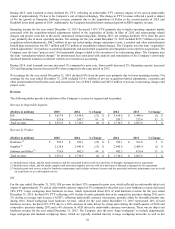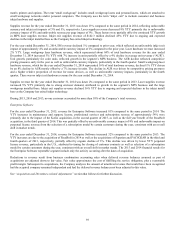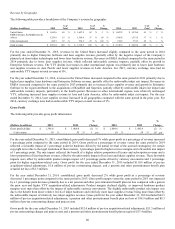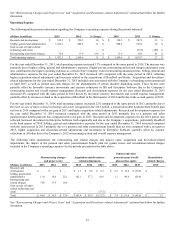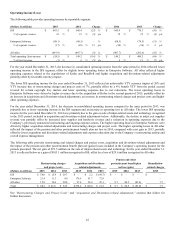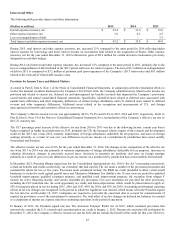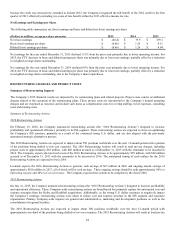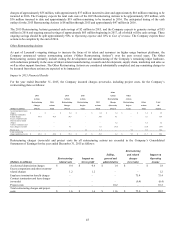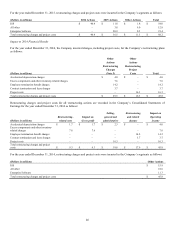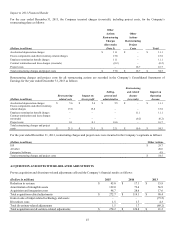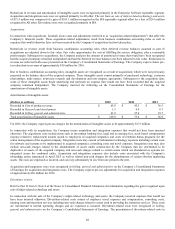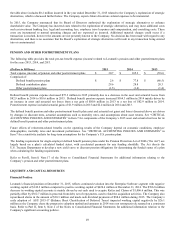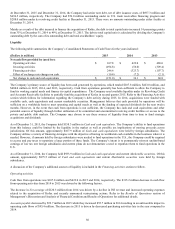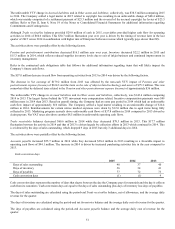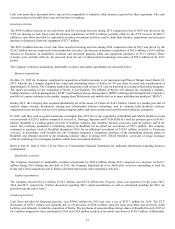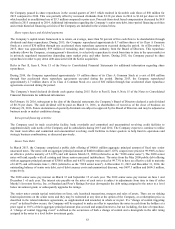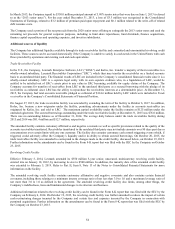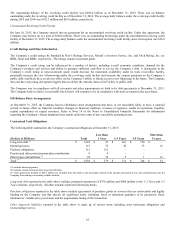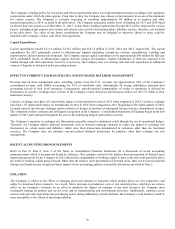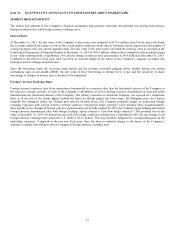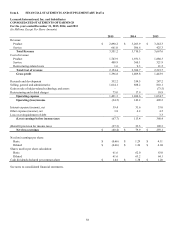Lexmark 2015 Annual Report Download - page 52
Download and view the complete annual report
Please find page 52 of the 2015 Lexmark annual report below. You can navigate through the pages in the report by either clicking on the pages listed below, or by using the keyword search tool below to find specific information within the annual report.
48
Reductions in revenue and amortization of intangible assets were recognized primarily in the Enterprise Software reportable segment.
Acquisition and integration costs were recognized primarily in All other. The net Gain on sale of inkjet-related technology and assets
of $73.5 million was composed of a gain of $103.1 million recognized in the ISS reportable segment offset by a loss of $29.6 million
recognized in All other. Divestiture costs were recognized primarily in ISS.
Acquisitions
In connection with acquisitions, Lexmark incurs costs and adjustments (referred to as “acquisition-related adjustments”) that affect the
Company’s financial results. These acquisition-related adjustments result from business combination accounting rules as well as
expenses that would otherwise have not been incurred by the Company if acquisitions had not taken place.
Reductions in revenue result from business combination accounting rules when deferred revenue balances assumed as part of
acquisitions are adjusted down to fair value. Fair value approximates the cost of fulfilling the service obligation, plus a reasonable
profit margin. Subsequent to acquisitions, the Company analyzes the amount of amortized revenue that would have been recognized
had the acquired company remained independent and had the deferred revenue balances not been adjusted to fair value. Reductions in
revenue are reflected in Revenue presented on the Company’s Consolidated Statements of Earnings. The Company expects future pre-
tax reductions in revenue of approximately $10 million for 2016.
Due to business combination accounting rules, intangible assets are recognized as a result of acquisitions which were not previously
presented on the balance sheet of the acquired company. These intangible assets consist primarily of purchased technology, customer
relationships, trade names, in-process research and development and non-compete agreements. Subsequent to the acquisition date,
some of these intangible assets begin amortizing and represent an expense that would not have been recorded had the acquired
company remained independent. The Company incurred the following on the Consolidated Statements of Earnings for the
amortization of intangible assets.
Amortization of intangible assets:
(Dollars in millions)
2015
2014
2013
Recorded in Cost of product revenue
$
65.8
$
45.2
$
36.5
Recorded in Research and development
1.3
0.8
0.7
Recorded in Selling, general and administrative
61.9
27.4
19.7
Total amortization of intangible assets
$
129.0
$
73.4
$
56.9
For 2016, the Company expects pre-tax charges for the amortization of intangible assets to be approximately $117 million.
In connection with its acquisitions, the Company incurs acquisition and integration expenses that would not have been incurred
otherwise. The acquisition costs include items such as investment banking fees, legal and accounting fees, stock based compensation
expense related to replacement awards issued to employees of acquired companies and costs of retention bonus programs for the
senior management of the acquired company. Integration costs may consist of information technology expenses including certain costs
for software and systems to be implemented in acquired companies, consulting costs and travel expenses. Integration costs may also
include non-cash charges related to the abandonment of assets under construction by the Company that are determined to be
duplicative of assets of the acquired company and non-cash charges related to certain assets which are abandoned as systems are
integrated across the combined entity. Acquisition and integration expenses also include costs associated with the Company’s
rebranding action announced in April 2015 as well as related non-cash charges for the abandonment of certain obsolete marketing
assets. The costs are expensed as incurred, and can vary substantially in size from one period to the next.
Acquisition and integration costs were recognized in Selling, general and administrative on the Company’s Consolidated Statements
of Earnings for acquisition and integration costs. The Company expects pre-tax adjustments for acquisition and integration expenses
of approximately $66 million for 2016.
Divestiture Activity
Refer to Part II, Item 8, Note 4 of the Notes to Consolidated Financial Statements for information regarding the gain recognized upon
sale of inkjet-related technology and assets.
In connection with the sale of the Company’s inkjet-related technology and assets, the Company incurred expenses that would not
have been incurred otherwise. Divestiture-related costs consist of employee travel expenses and compensation, consulting costs,
training costs and transition services including non-cash charges related to assets used in providing the transition services. These costs
are incremental to normal operating charges and are expensed as incurred. Divestiture-related costs were recognized in Selling,
general and administrative on the Company’s Consolidated Statements of Earnings. The presentation of divestiture-related costs in


